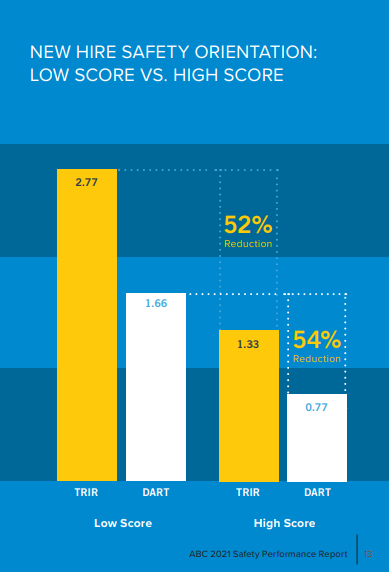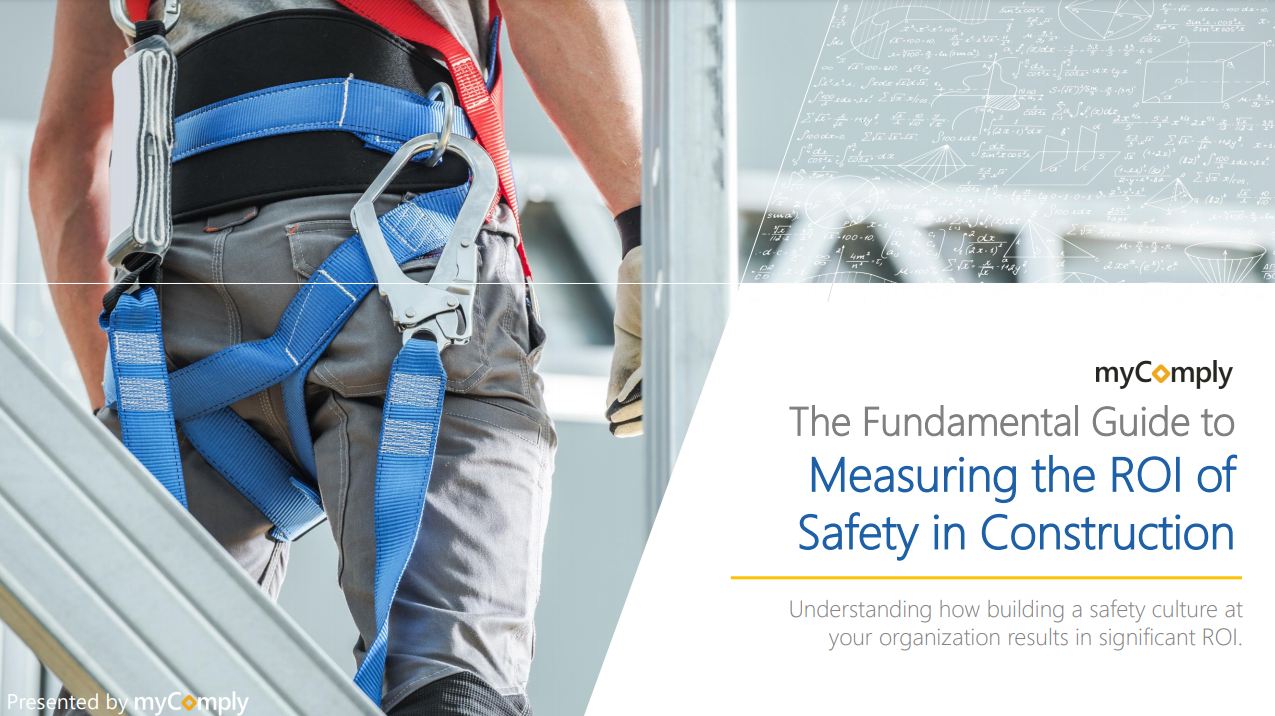Every construction professional knows that injuries and incidents bear many negative repercussions with respect to workplace operations. But, without an accurate way of measuring the impact of these incidents, it can be difficult to assess and communicate the need for safety reform. That’s why calculations like DART rate exist.
Some of the questions that a DART rate calculation aims to provide insight into include:
- What is the business impact of incidents?
- How many incidents result in workers compensation claims?
- How many incidents lead to lost time or productivity?
- How do incidents effect output? Profitability…?
This article explores what a DART rate is, who uses it, how to calculate DART rate, how it compares to other safety measurements, why it matters in construction, and proven strategies that general contractors and construction managers can leverage to reduce DART rate at their firms.
Table of Contents
What is DART Rate?
Who Uses DART Rate?
1. Internal Teams & Leadership
2. Regulatory Bodies
How to Calculate DART Rate
DART Rate and Total Recordable Incident Rate (TRIR)
Why DART Rate Matters in Construction
1. Working Relationships
2. OSHA Inspections
3. Insurance Implications
How to Reduce Your DART Rate
1. Validate Your Input Data
2. Implement Proven Safety Processes
3. Invest in Safety Orientations
4. Ensure Your Workforce is Qualified
Conclusion
What is DART Rate?
Days away, restricted, or transferred (DART) is a measurement that was introduced by the Occupational Safety and Health Administration (OSHA) to assess the safety of your construction firm based on the type and quantity of workers’ compensation-related injuries or illnesses within a given timeframe.
DART rate accounts for three possible employee-involved incidents:
- Away incidents. The number of days absent resulting from a work-related illness or injury.
- Restricted incidents. The number of days an employee is placed under a work restriction (no heavy lifting, must sit while working, etc).
- Transferred incidents. The number of days an employee is transferred to another job because they could not fulfill their normal working duties.
Now, let’s explore the use cases for DART rate calculations.
Who Uses DART Rate?
DART rate is often measured and assessed by two different stakeholders, those being internal teams (ex. environmental, health and safety (EHS) representatives and executive leadership) and external regulatory bodies (ex. OSHA and other federal, state, or municipal authorities).
1. Internal Teams & Leadership
Though most companies track their number of recordable incidents and associated days away from work, not all go so far as to measure the number of days that are restricted or transferred work. It is important for companies to monitor these days and assess DART rate because any days of restricted work on transfer-required work result in reduced productivity, and, therefore, profitability.
Assessing restricted or transferred work allows construction firms to get a more holistic grasp of how safety-related incidents actually affect your company’s bottom line.
2. Regulatory Bodies
DART rate is used by OSHA and other regulatory bodies (ex. New York Department of Buildings) as a metric to assess the safety of operations within firms. Firms with higher DART rates should expect to be frequented for “random” safety inspections more often than those that report market competitive or below average DART rates.
Now, let’s explore a DART rate calculation.
How to Calculate DART Rate
To calculate DART rate, you need to leverage the following equation:
(The total number of missed workdays + the number of days where workers were on restricted work duty + the number of days where workers required a transfer of work duties) x 200,000 / Total hours worked by all employees
Here are some notes regarding the DART rate formula:
- The 200,000 is the product of 100 employees working 40-hour weeks for 50 weeks (leaving out two weeks to account for holiday time). In other words, a rough approximation of the total hours 100 employees would work in one calendar year.
- All workers that conducted contract work over the calendar year should be included in your calculation, both their hours worked and their days away, restricted, or transferred, resulting from their work.
Here is a sample DART rate calculation for a company with 500,000 annual hours worked, where workers missed two days as a result of incident, and required two days of restricted work:
DART Rate = (2 + 2) x 200,000 / 500,000
DART Rate = 1.6
DART Rate and Total Recordable Incident Rate (TRIR)
If you are familiar with TRIR, you might be thinking that a DART rate sounds very familiar. Though a DART rate is similar to a TRIR calculation, there are a few noteworthy differences.
Here are some of the key differences between DART rate and TRIR:
- TRIR represents the total OSHA-recordable incidents within a company. This means that TRIR should account for nearly all incidents within your organization, except for what can be easily addressed with a first aid kit. DART rate is associated with much more severe incidents as it is tied to work exemptions and exceptions.
- DART rate should, therefore, be lower than TRIR, as there should be fewer incidents requiring work exemptions than total OSHA-recordable incidents within your firm. Otherwise, it would suggest that nearly all your work-related incidents were severe enough to lead to days away, restricted, or transferred.
For example, the company with a DART rate of 1.6 (above) may have had a total incident volume of 6, which would lead to the following TRIR calculation:
TRIR = 6 x 200,000 / 500,000
TRIR = 2.4
Learn More: How to Calculate Total Recordable Incident Rate (TRIR)
Why DART Rate Matters in Construction
In the construction sector, maintaining a respectable DART rate is important for the prolonged health and wellbeing of your company. Here are some of the key reasons why:
1. Working Relationships
In the construction sector, many businesses request information such as a companies DART rate before determining whether or not they would like to work with another firm. If you are a general contractor with a high DART rate, then you may have difficulty landing new projects, attracting subcontractor talent, and even procuring suppliers.
2. OSHA Inspections
As mentioned before, exceptionally high DART rates can actually prompt more frequent site inspections by OSHA and other regulatory bodies. These inspections tend to cover everything from your training and safety programs to your record keeping and on-site worker compliance. These inspections are not only inconvenient, but they can also be costly. In fact, safety violations can lead to tens of thousands of dollars in fines, and can often be accompanied with stop work orders, which can be even more damaging to project margins and timelines.
Recently, the New York Department of Buildings ran a three-month “zero tolerance” safety initiative across state construction sites. During this time, 7,500 sites were inspected, leading to 3,600 safety violations and fines, as well as 1,499 stop work orders.
3. Insurance Implications
If you are a general contractor or a construction manager, then you are either leveraging a wrap-up insurance program or a traditional insurance program on your projects. When applying for coverage, insurance providers use an assessment known as experience modification rating (EMR) to calculate the cost of insurance premiums. This equation factors in components such as actual losses in the past and uses these numbers to project expected losses in the future. In other words, DART rates and TRIR scores are directly tied to the calculation of your insurance premiums.
Learn More: Experience Modification Rating (EMR Rating) Explained
Or download our Fundamental Guide to Measuring the ROI of Safety in Construction!
How to Reduce Your DART Rate
General contractors and construction managers do not have to fall victim to their DART rates, in fact, there are a number of proven strategies, processes, and technologies that can help your construction firm to improve overall safety and, therefore, reduce your DART rate.
1. Validate Your Input Data
As a result of the weight put on each of your days away, restricted, or transferred, a miscalculation of input data can lead to dramatic impacts on your DART rate.
Here’s how to validate your inputs for DART rate:
- Do not round days away, restricted, or transferred to the nearest full day. If a worker requires transfer work for an afternoon, then that should be documented as a half day.
- Ensure that all worker hours are being logged in your calculation of total hours worked in the year, including salaried employees and contracted workers. Failure to account for all hours contributing to organizational outcomes can lead to an inflated DART rate.
- Benchmark yourself against the right cohort within your industry by verifying your North American Industry Classification System (NAICS) code. Here is a database of the various NAICS codes and their association TRIRs and DART rates.
2. Implement Proven Safety Processes
Accidents do happen, but, for the most part, DART rate can safely be considered the direct product of the safety programs and initiatives put in-place by leadership. A safety focus in construction can be instrumental in improving safe operations, reducing incidents, reducing site inspections by municipal, state, and federal authorities, and driving profits.
Organizations like the Associated Builders and Contractors (ABC) use certain leading metrics to measure the safety of construction firms and award top performers with certification through their STEP program.
In essence, STEP is a safety management program that assesses construction firms on key metrics, such as:
- Trailing metrics like near misses, unsafe acts, unsafe conditions, and more.
- Implementation of safety programming, such as substance abuse programs, orientations, toolbox talks, and more.
- Safety policies, such as emergency action plans, incident investigation protocols, and more.
Earning certification in STEP means prioritizing safety in all that you do, and the reward is dramatic safety improvements. In fact, STEP certified construction companies are proven to be a staggering 655% safer than noncertified firms. This means fewer incidents, a stronger safety culture, and a lower DART rate.

3. Invest in Safety Orientations
One of the best preventative strategies in the toolbox of construction leaders is the site safety orientation. Studies have persistently proven that companies that invest in their site inductions are able to realize lower rates of incident and, therefore, reductions in DART rate. In fact, an ABC study demonstrated that contractors that conduct in-depth construction orientations realize 52-54% lower DART rates as compared to companies that offer more basic orientations.

Source: ABC 2021 Safety Performance Report
According to ABC, here is how you can improve your site safety orientations:
- Provide workers with detailed information on site expectations and worker-specific responsibilities.
- Clarify and demonstrate all reporting procedures for injuries, incidents, hazards, and emergency communication.
- Provide general and task-specific demonstrations of all personal protective equipment (PPE), as well as any machinery that will be used on-site.
- Deploy regular safety performance evaluations and assessments to keep workers accountable for their safety behavior throughout the duration of the project.
- Use construction technology solutions to help you standardize the delivery of construction orientations across projects. myComply’s Orientations module is one of the leading solutions for contractors looking to digitize some of or all of their orientation programs.
4. Ensure Your Workforce is Qualified
One of the greatest threats to worker safety on all construction projects is untrained or uncertified workers. In fact, a 2018 study conducted by the USG Corp. and the US Chamber of Commerce found that 58% of construction leaders believe that dangerous work sites were attributed to unskilled workers.
One of the greatest barriers to ensuring all construction workers are adequately trained to be conducting work on projects is the tracking and management of worker certifications. Fortunately, solutions like myComply give asset owners, general contractors, construction managers, and subcontractors the ability to set certification requirements for every worker before they can enter a project site.
Conclusion
Assessments of safety-related metrics such as DART rates are a reactive (or trailing) way of assessing overall operational wellness. Fortunately for construction firms, there are proactive (or leading) measures that can be implemented to improve site safety and promote more productive and profitable projects.
Just remember the four keys to improving your DART rate:
- Validate all of your input data
- Improve your safety culture with proven safety processes
- Invest in more comprehensive construction site orientations and worker training
- Use construction compliance software to ensure workers are 100% qualified
If you are ready to take aim at preventing the incidents that lead to days away, restricted, or transferred on your jobsites, then book a demo with a myComply product expert today.




